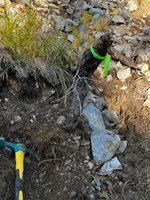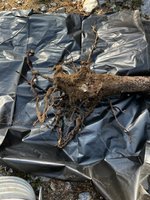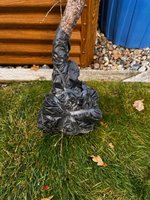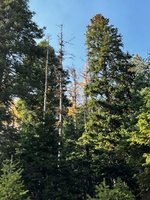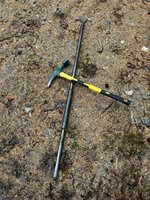For hauling it up there with the rest of your gear, it may be more convenient to buy one of those bricks of dry, compressed sphagnum moss and a water bottle. Then, you could just put the brick in a plastic bag, pour in the water, and let the sphagnum brick moisten and expand on-site while you’re digging up the tree.Damp sphagnum moss should work good too.
You are using an out of date browser. It may not display this or other websites correctly.
You should upgrade or use an alternative browser.
You should upgrade or use an alternative browser.
YAMADORI COLLECTING QUESTION
- Thread starter August44
- Start date
Gabler
Masterpiece
For hauling it up there with the rest of your gear, it may be more convenient to buy one of those bricks of dry, compressed sphagnum moss and a water bottle. Then, you could just put the brick in a plastic bag, pour in the water, and let the sphagnum brick moisten and expand on-site while you’re digging up the tree.
But why bring anything at all? It's extra weight; you risk additional damage to the roots when you get down the mountain and pull it off; and it provides no benefit to the tree whatsoever. Just mist the roots and put them in a plastic bag to seal in moisture.
Depending on the volume of roots (and, particularly, if there are some big, rigid roots to be kept together with feeder roots that will require a large amount of air to be included inside the bag) and the time delay between when the tree is collected and when it arrives at your home and is potted up, it’s certainly possible for localized drying of some roots to occur even within a plastic bag. At a minimum, it makes sense to wrap the roots in some wet paper towel or other absorbent material that holds water.But why bring anything at all? It's extra weight; you risk additional damage to the roots when you get down the mountain and pull it off; and it provides no benefit to the tree whatsoever. Just mist the roots and put them in a plastic bag to seal in moisture.
BrianBay9
Masterpiece
Agree. I've collected some Ponderosa pine from similar sites. Success rate goes down, and could never work the roots back to get them into pots.1. Spray bottle to mist the roots and bag before closing and wrapping. keep cool, would not bother adding other material.
2. pure pumice after collection and humidity tent if possible.
3. Consider carefully if the roots can be adapted for Bonsai easily, my experience with trees from similar sites raises a red flag in this aspect.
My strongest suggestion due to the low success rate over time with bare root conifers trees collected from rock sites is to choose other collection sites. Even if some survive the first season or two , often the roots are almost impossible to reduce down and create feeder root formation close enough to the trunk for bonsai pot placement. Many of the trees require slab planting or one of a kind custom containers in the end. Yamadori are often reduced in value when their root structure proves difficult for bonsai purposes. Just a reflection based on my experience .
River's Edge
Masterpiece
It has been my experience that anchor roots and thicker roots are usually spaced apart with adequate space between for finer roots to sit. I concur that it makes sense to have some absorbent material to hold moisture if they are to be transported distance or remain bagged for considerable time. For this purpose I reuse old sacks or towels on the outside ( moistened) before closing the plastic bag and wrapping as tight as possible. The tight wrapping is critical to prevent additional root damage. Trying to add substrate between roots will simply increase the root damage to finer roots in my opinion.Depending on the volume of roots (and, particularly, if there are some big, rigid roots to be kept together with feeder roots that will require a large amount of air to be included inside the bag) and the time delay between when the tree is collected and when it arrives at your home and is potted up, it’s certainly possible for localized drying of some roots to occur even within a plastic bag. At a minimum, it makes sense to wrap the roots in some wet paper towel or other absorbent material that holds water.
Far better to retain as much soil as possible in the first place. The rest just is an attempt to correct a bad situation that should be avoided if at all possible. Enough said, no extra value in beating this thought to death.
Gabler
Masterpiece
Depending on the volume of roots (and, particularly, if there are some big, rigid roots to be kept together with feeder roots that will require a large amount of air to be included inside the bag) and the time delay between when the tree is collected and when it arrives at your home and is potted up, it’s certainly possible for localized drying of some roots to occur even within a plastic bag. At a minimum, it makes sense to wrap the roots in some wet paper towel or other absorbent material that holds water.
Agree. I've collected some Ponderosa pine from similar sites. Success rate goes down, and could never work the roots back to get them into pots.
It has been my experience that anchor roots and thicker roots are usually spaced apart with adequate space between for finer roots to sit. I concur that it makes sense to have some absorbent material to hold moisture if they are to be transported distance or remain bagged for considerable time. For this purpose I reuse old sacks or towels on the outside ( moistened) before closing the plastic bag and wrapping as tight as possible. The tight wrapping is critical to prevent additional root damage. Trying to add substrate between roots will simply increase the root damage to finer roots in my opinion.
Far better to retain as much soil as possible in the first place. The rest just is an attempt to correct a bad situation that should be avoided if at all possible. Enough said, no extra value in beating this thought to death.
Thanks. That makes sense.
Update: I went up yesterday and collected one of the Larch. The pictures show pretty much what went on and the country where it was collected. Really like going up there even if I don't collect. This time of year with the Larches turning and the reds and yellows of ground covers and low growth plants is heartwarming to me and gives me vivid real memories to get me through the long, cold winter.
Terrible digging conditions to say the least. The roots are so-so, but no soil with them is not good. I am certainly aware of the faults of this whole operation but thought I would try to collect one and see how it went. I collected a larch about this size last year with far less roots and it is alive with growth this year. I had a bag of the smaller granules of perlite that I soaked up and took with me to keep things damp. I know some of you disagree with the need for that but it is very light and did what I wanted it to do. It will readily fall off when unwrapped for potting up. You can see the larger, curled larch that would make a wonderful bonsai that I left. That's a Randy Knight tree me thinks. I have trouble collecting anymore because of arthritis in my right wrist. Pretty painful to swing the pick and work with the bar.
Terrible digging conditions to say the least. The roots are so-so, but no soil with them is not good. I am certainly aware of the faults of this whole operation but thought I would try to collect one and see how it went. I collected a larch about this size last year with far less roots and it is alive with growth this year. I had a bag of the smaller granules of perlite that I soaked up and took with me to keep things damp. I know some of you disagree with the need for that but it is very light and did what I wanted it to do. It will readily fall off when unwrapped for potting up. You can see the larger, curled larch that would make a wonderful bonsai that I left. That's a Randy Knight tree me thinks. I have trouble collecting anymore because of arthritis in my right wrist. Pretty painful to swing the pick and work with the bar.
Attachments
Similar threads
- Replies
- 536
- Views
- 25K
- Replies
- 732
- Views
- 53K

